What are the best food choices when you take antibiotics?
Over the last 100 years, antibiotics have saved millions of lives. While on the one hand, these medicines kill disease-causing bacteria and are an essential part of life-threatening infection treatments, antibiotics also destroy beneficial gut bacteria and have an adverse impact on your gut health. Eating food rich in healthy gut bacteria while (and after) taking antibiotics should, therefore, be an integral part of any antibiotic therapy.
In this post, we shall take a detailed and evidence-based look at some foods you should eat while on antibiotics.
What are antibiotics and how they affect your gut health?
Antibiotics are a group of medical drugs used in the treatment of bacterial infections, such as respiratory tract infections (pneumonia, sinusitis, etc.), UTI (urinary tract infections) or brain infections (meningitis, etc.).
Without antibiotics, treatment of many life-threatening diseases would not be possible and people would die.
The first antibiotic drug, penicillin, which we still widely use, was discovered by Sir Alexander Flemming, back in 1928 (1).
Since then, hundreds of different antibiotics were made or discovered, falling into two main groups - e.g. the broad spectrum antibiotics and the narrow spectrum antibiotics.
The broad spectrum antibiotics (such as gentamicin or amoxicillin) kill a wide range of bacterial strains, while the narrow spectrum antibiotics (such as penicillin) kill only a few types of bacteria (2).
Antibiotics are usually taken orally (e.g. they pass through your digestive system) or intravenously (IV).
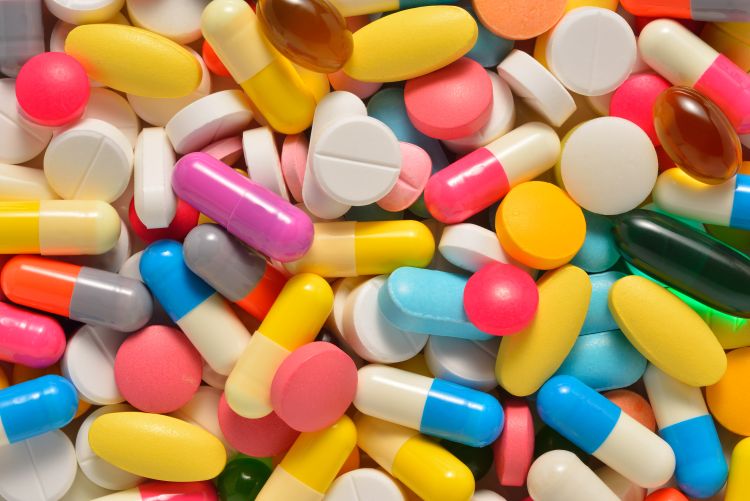
Antibiotics are useful but destroy your gut microbionta
As you probably know your gut is a home to many bacteria, both good or healthy ones, as well as dangerous or harmful ones.
There is a whole gut ecosystem called microbiome (or gut microbiota), which consists of bacteria, fungi and other microbes. Normally, the gut microbiome is balanced (e.g. there is a balance between good and bad bacteria, fungi, etc.).
When you take antibiotics, they usually kill both harmful bacteria (e.g. the ones that cause infections), as well as the healthy bacteria in your gut (3, 4).
This puts your gut microbiome out of balance and causes some common side effects associated with antibiotic use, such as diarrhea, nausea and even vomiting.
The major issue is that antibiotics kill both good and bad bacteria in your gut, but they do not destroy yeast (fungi), such as Candida.
In a healthy gut, yeast is usually held in check by good gut bacteria, which prevent their overgrowth.
But once there are no healthy gut bacteria to regulate the growth of Candida, the fungus may start spreading through your digestive system and cause various disorders, including leaky gut syndrome and autoimmune diseases.
What is more, intestinal bacteria produce some essential nutrients and vitamins, such as vitamin K2 (menaquinone), which is essential for blood clotting and bone health or biotin (vitamin H), vitamin B12, folic acid (vitamin B9), and thiamine (vitamin B1) (5).
Gut flora also ferments dietary fiber to produce short-chain fatty acids (such as butyrate, acetate or propionate), which improve your gut health.
So if you take antibiotics, you should eat foods or supplements, which restore healthy gut bacteria (6).
These foods contain probiotics or healthy intestinal microorganisms, such as Lactobacillus and Bifidobacterium species.
It is also a good idea to consume foods that are high in vitamins K2, B12, H, B9 and B1 to offset the temporary decrease in their production.
Here is a list of foods you should eat while on antibiotic treatment (and beyond):
Foods high in probiotics
Probiotics are healthy intestinal microorganisms. When you take antibiotics, they destroy your healthy gut microbionta and increase the risk of overgrowth of unhealthy gut flora.
By consuming probiotics, you restore your healthy intestinal bacteria and prevent the excessive growth of fungi (e.g. Candida) and dangerous bacteria, such as Clostridium Difficile, which is a common cause of post-antibiotic collitis (inflammation of the large intestine).
Here is a list of some of the best probiotic containing foods.
Yogurt
Yogurt is one of the richest sources of probiotic bacteria, including Lactobacillus and Bifidobacterium strains (7).
It is a good idea to eat yogurt to restore healthy gut microbiota as both probiotics and yogurts have a short shelf-life and must be consumed very quickly after purchase.
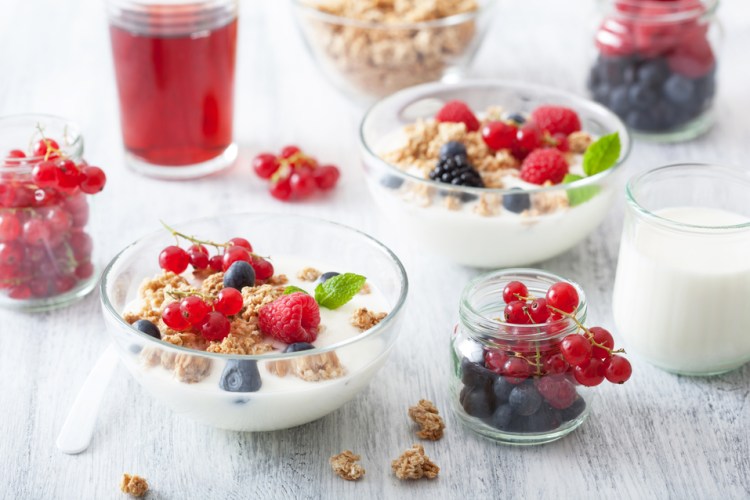
Yogurt is a rich source of active probiotic bacteria
In addition to being an excellent source of probiotics, yogurt also has many other health benefits, such as bone health, prevention and treatment of antibiotic-associated diarrhea in children or easing the IBS (Irritable Bowel Syndrome) symptoms (8, 9, 10).
You may eat yogurt safely even if you are lactose intolerant as probiotics turn lactose in yogurt into lactic acid, which is easier digestible than lactose.
Do not eat yogurt immediately after you take your antibiotics but wait for about 3 hours before you consume some.
Also, make sure you buy quality yogurts, which contain live probiotic bacteria as some products sold in supermarkets do not contain any probiotics as they have been killed during milk processing.
So read the product label carefully and only buy yogurts with live or active probiotic strains and with no added sugar.
Kefir
Kefir is another great source of probiotics to prevent post-antibiotic health issues.
To make it, you just need to add kefir grains, which contain the probiotic bacterial strains, to goat’s or cow’s milk.
The fermentation process takes about 24 - 48 hours.
Some experts claim that kefir is a better source of probiotics than yogurt as it contains more healthy probiotic strains than yogurt (11).
It also has anti-inflammatory and anti-microbial properties and helps keep your gut in good shape (12).
Again, make sure you consume kefir 2 to 3 hours after you took your antibiotics to avoid bloating and other gastrointestinal issues.
Non-dairy probiotic foods
In addition to milk (dairy) based probiotic foods, probiotic bacteria can also be found in many non-dairy foods, such as sauerkrout or tempeh.
Sauerkrout is made by lactic fermentation of finely chopped cabbage.
It is a rich source of probiotics (e.g. lactic acid bacteria).
You may eat sauerkraut just as a plain food or add it to your sausage, meat or other meals.
Consuming sauerkraut while on antibiotics is helpful not only because of its rich probiotic content, but also due to the fact, that it is high in vitamins K, C and B (13).
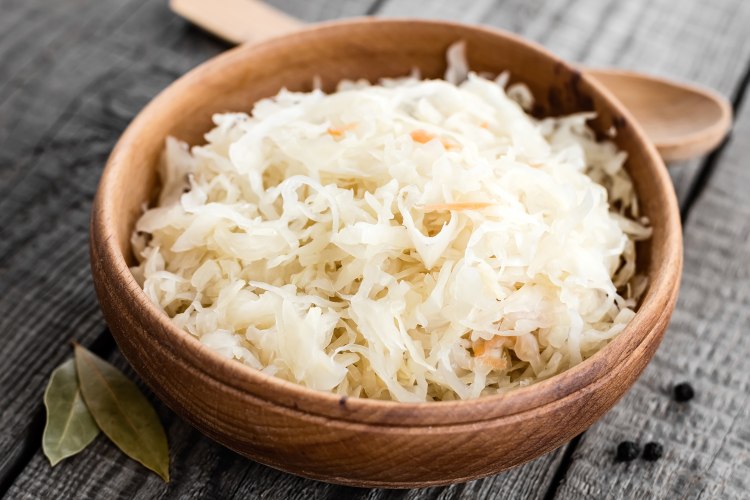
Sauerkraut is a rich source of healthy probiotic bacteria
And as we already know, antibiotic treatment may make you deficient in these vitamins.
What is more, sauerkraut is an excellent source of antioxidants (lutein and zeaxanthine), which promote your eye health (14).
If you want to try sauerkraut as a probiotic food, get some unpasteurized one.
Pasteurization destroys probiotic bacteria, so pasteurized sauerkraut contains no probiotics.
Tempeh is made by fermentation of soybeans by lactic acid bacteria.
It is a nutritious and probiotic-rich food.
It also contains some vitamin B12, which is only found in a small number of plants (15).
Therefore it may be a good vitamin B12 source for vegetarians.
Adding tempeh to your post-antibiotic treatment diet is a good idea.
Foods high in vitamin K
Intestinal bacteria produce vitamin K, which is involved in blood clotting, wound healing and bone health.
Adequate daily intake of vitamin K is 90 micrograms a day for adult women and 120 micrograms a day for adult men (16).
Antibiotics destroy bacteria producing vitamin K, which means, that you should increase its intake while on antibiotic treatment.
However you should eat food containing vitamin K with moderation if you are on blood-thinning medication (e.g. Coumadin) as it may impair efficiency of these drugs.
But it is no good to avoid eating vitamin K rich foods completely if you take Coumadin as it may cause vitamin K deficiency (17).
The foods below are excellent sources of vitamin K to be add to your diet post-antibiotic treatment.
Dark green leafy vegetables
The richest sources of vitamin K are kale (1021% DV of vitamin K per 100 g), spinach (1111% DV of vitamin K per 100 g) and collards (966% DV of vitamin K per 100 g).
In addition to being high in vitamin K, these foods also contain many antioxidants and phytonutrients and are rich in fiber, which serves as food (e.g. prebiotic) for healthy gut bacteria.
Foods high in vitamin B12
Vitamin B12 is essential for proper development of red blood cells and its deficiency may result in anemia. As it is partly produced by health gut bacteria, you should increase its intake while you take antibiotics (as well as post-ATB treatment).
Adequate daily intake is 2.4 mcg. Pregnant and breast feeding women should get between 2.6 - 2.8 mcg a day (18).
Vitamin B12 is also helpful in treatment of memory loss, mood disorders, heart diseases and may also prevent diabetic nerve damage (diabetic neuropathy).
Its best sources are fish (salmon: 54% DV in a 100 g serving), red meat (beef: 50% DV in a 100 g serving) and dairy products (Swiss cheese: 73% DV in a 100 g serving).
Foods rich in folic acid
As gut bacteria also produce folic acid, it makes sense to add some foods rich in folic acid to your diet after an antibiotic treatment.
Folic acid is important for your brain, muscle and eye health. It is also essential for proper red blood cell development. Pregnant women need to get adequate amounts of folic acid to ensure appropriate development of their child as folate deficiency is associated with birth defects, such as spina bifida (19).
Folate may also be helpful in prevention of ovarian and colon cancer, heart diseases and stroke.
The recommended daily value (RDV) for folic acid is 400 to 800 micrograms.
The richest sources of folic acid are spinach (49% DV in a 100 g serving), beets (27% DV in a 100 g serving), peanuts (76% DV in a 100 g serving) and other dark green leafy vegetables (such as broccoli).
Some organ meats, such as turkey liver (173 % DV in a 100 g serving) are also an excellent source of vitamin B9.
Foods rich in vitamin B1
Vitamin B1 (thiamine) deficiency causes nerve damage and heart diseases. It is also necessary for appropriate function of muscles.
While we usually get an adequate amount of this vitamin from the foods we eat, it may be a good idea to eat more foods high in thiamine after being treated with antibiotics.
The recommended daily allowance for vitamin B1 is between 1 and 1.4 mg (20).
Pregnant and lactating women should get more vitamin B1 than other people. Also men need more vitamin B1 than women.
The best food sources of vitamin B1 include sunflower seeds (43% DV in a 35 g serving), lentils (28% DV in a 198 g serving) and oats (25% in a 39 g serving).
Organ meat (liver) and red meat are also rich in vitamin B1.
Foods to avoid while on antibiotics
Antibiotics may interact with certain foods. Interactions may either lower their efficiency or increase toxicity and side effects.
You should know that antibiotics should not be taken with milk and dairy products, which contain calcium and magnesium, as these minerals may lower the absorption of antibiotics in the gut (21).
That said you may consume dairy products while on antibiotics but not immediately after you have taken your antibiotic drugs.
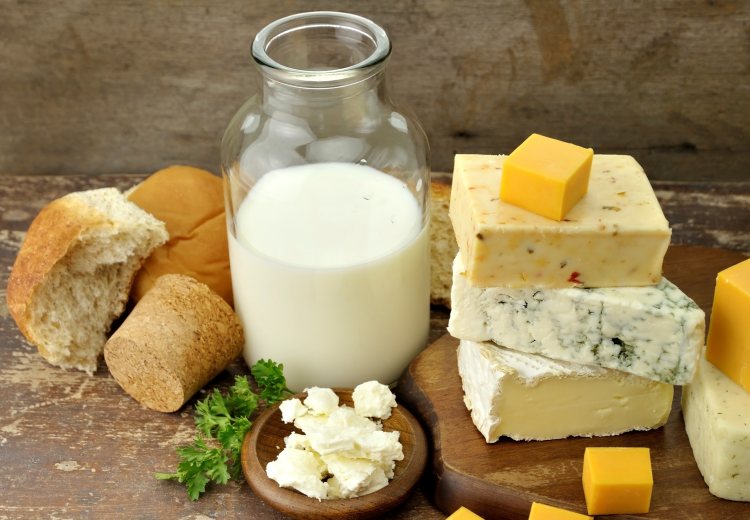
Dairy products should not be eaten with antibiotics
Always read the information on your antibiotic leaflet to see, which foods you should avoid while taking your medicine.
Should you eat nutrient rich foods or supplements while on antibiotics?
In general it is always better to get all nutrients in a natural, organic form, e.g. from food. However if suffer from serious digestive side effects while taking antibiotics and need to get large amounts of probiotics, taking probiotic and/or vitamin supplements may be a good idea.
Talk to your doctor before you start taking any probiotic supplements!
The takeaway
Antibiotics destroy both bad and good bacteria in your gut, which may cause imbalance of your gut microbiome.
You should therefore make sure you eat enough probiotics (e.g. healthy bacteria) to restore tha balance. Some foods high in probiotics include yogurt, kefir, tempeh or sauerkraut.
It is also helpful to increase the intake of vitamins K, B12, thiamine and folic acid while on antibiotics.
Never consume milk and dairy products containing high levels of calcium and magnesium at the same time as you take your antibiotics as it has a negative impact on antibiotic absorption in your gut.
You should also never eat dairy-based probiotic foods with antibiotics but consume it at least 2 - 3 hours after you took your last antibiotic dose.
Before taking probiotic and vitamin supplements always ask your doctor for consent!
| Written by: | Michal Vilímovský (EN) |
|---|---|
| Education: | Physician |
| Article resources: | See numbered references in the article. |
| Image resources: | Stockphotosecrets.com and Adobestock.com |
| Published: | April 24, 2017 at 5:25 AM |
| Next scheduled update: | April 24, 2019 at 5:25 AM |
Get more articles like this in your inbox
Sign up for our daily mail and get the best evidence based health, nutrition and beauty articles on the web.

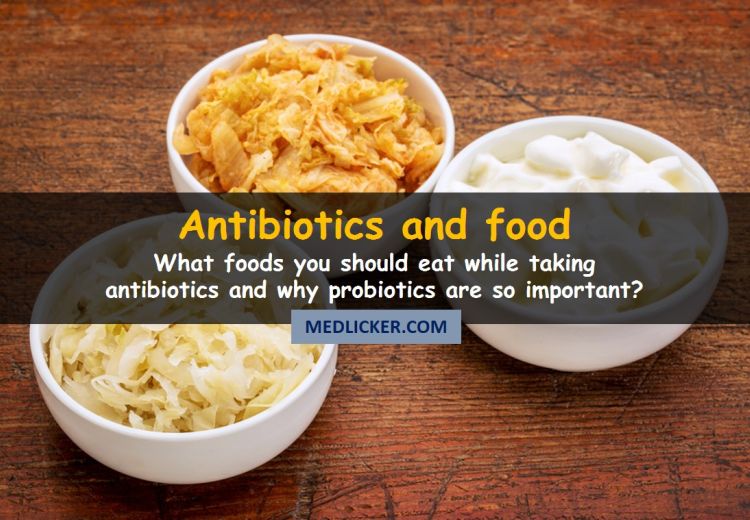
Ache in left arm that you should not ignore
Alkaline water dangers: why you should not drink it
How to Avoid Sleepiness While Studying?
23 Foods That Increase Leptin Sensitivity
Low dopamine (e.g. dopamine deficiency): causes, symptoms, diagnosis and treatment options
Swollen taste buds: the ultimate guide to causes, symptoms and treatment
Thin endometrial lining: causes, symptoms, diagnosis and treatment
Pimples inside nose: the complete guide
Holes in tonsils: definition, symptoms, treatment and prevention
How to deal with an ingrown hair cyst
Allegra vs. Zyrtec vs. Claritin
Allergy to penicillin and alternative antibiotics
How to get rid of phlegm (excessive mucus) in throat? Detailed guide to medical and home remedies, symptoms and causes
What causes stomach ache after meals?
Liver blood test results explained